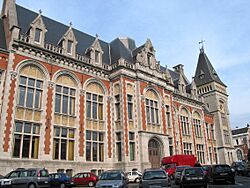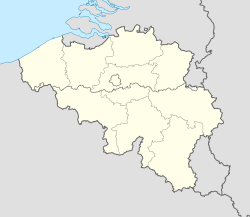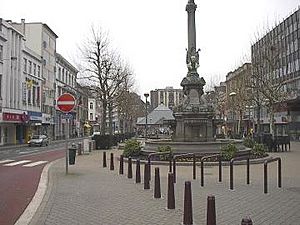Verviers facts for kids
Quick facts for kids
Verviers
Vervî (Walloon)
|
|||
|---|---|---|---|

Palais de Justice (courthouse)
|
|||
|
|||
| Country | Belgium | ||
| Community | French Community | ||
| Region | Wallonia | ||
| Province | Liège | ||
| Arrondissement | Verviers | ||
| Area | |||
| • Total | 33.07 km2 (12.77 sq mi) | ||
| Population
(2018-01-01)Lua error in Module:Wd at line 1575: attempt to index field 'wikibase' (a nil value).
|
|||
| • Total | Lua error in Module:Wd at line 1,575: attempt to index field 'wikibase' (a nil value). | ||
| Postal codes |
4800, 4801, 4802
|
||
| Area codes | 087 | ||
| Website | www.verviers.be | ||
Verviers is a city and a local area (called a municipality) in Wallonia, Belgium. It is located in the province of Liège.
The municipality includes several smaller towns like Ensival, Heusy, Lambermont, Petit-Rechain, Stembert, and Verviers itself. It's also part of a larger urban area with Dison and Pepinster. This makes Verviers the second-largest city in its province and an important local hub. It sits about halfway between the city of Liège and the German border.
Water has always been very important for Verviers. It helped the city grow its textile industry and later its tourism. Because of this, many beautiful fountains were built in Verviers. This led to the city being called Wallonia's "Water Capital." The main offices for water distribution and water treatment in Wallonia are also located here.
Contents
History of Verviers
Early Settlements
People have lived in the Verviers area for a very long time. We know this because old tools made of flint and bone, as well as Roman coins, have been found here. In the 4th century, the Romans tried to stop Germanic tribes from moving into the area. Eventually, the Salian Franks, led by Clovis, took over the region around the end of the 5th century.
At that time, the Verviers area was mostly covered in forests. It became a hunting ground for the Merovingian kings. Monks from the nearby Abbey of Stavelot slowly helped to spread Christianity in the region.
From the Middle Ages to Modern Times
In the late 10th century, a powerful leader named Charles the Simple gave the Marquisate of Franchimont to Notker of Liège. This was part of Notker's plan to strengthen the Prince-Bishopric of Liège, which was a powerful church-led state. Liège took full control of the marquisate in 1014. This was later confirmed by important figures like Emperor Frederick Barbarossa and Pope Adrian IV in 1155.
The first records of a textile industry in Verviers are from the 15th century. By the 16th century, making cloth became more important than metalworking. This happened partly because of the Eighty Years War happening in the nearby Netherlands. Verviers was still a small town then. But in 1651, as the cloth-making industry grew, Verviers was recognized as one of the main cities of the Prince-Bishopric of Liège.
The end of the 18th century was a difficult time due to the French Revolution. When Liège became part of France in 1795, the economy of Verviers suffered greatly. Many people became very poor. However, things improved after the Battle of Waterloo in 1815. Verviers was at the eastern end of the "sillon industriel," which was like the industrial backbone of Wallonia.
Even during the wars, the textile industry kept growing. A skilled industrialist named William Cockerill came to Verviers in 1799. He brought new machines and ideas from British factories, which started a new era for the textile industry in Verviers. After this, roads were built, gas lights were installed, and the city grew much bigger because of the Industrial Revolution. After World War I, Verviers was known as one of the "Wool Capitals of the World," sharing the title with Bradford in the UK.
The Big Flood of 2021
On the night of July 14-15, 2021, the Vesdre river overflowed its banks. This caused huge damage from the water. There was an extremely heavy rainfall that night, and the dam of the reservoir in Eupen had to be opened. The damage to homes and property was immense. Many people said it was worse than the damage caused during World War II.
Verviers' Economy
Verviers used to be famous for its wool and textile industry. This industry was known for its high quality and helped the town grow a lot. However, starting in the 1950s, local factories found it hard to compete with companies from other countries. Many factories closed, which led to a decline in the town's economy.
Since the mid-1990s, the economy has been slowly getting better, but it's still a bit fragile. In recent years, several new shopping centers have opened. These aim to bring new life to the areas that were most affected by the factory closures.
Places to See in Verviers
- Verviers has several interesting museums. One of them is the Wool and Fashion Tourist Centre. It's located in an old factory building that has a beautiful Neoclassical style.
- The Grand Theatre, also known as La Bonbonnière, was built in a similar style in the late 19th century. The Grand Poste (main post office) was built in the Neogothic style, which looks like older castle architecture.
- The city also has many interesting fountains and walking paths where you can explore different themes.
Famous People from Verviers
Many talented people were born or lived in Verviers. Here are a few:
- Jean-Jacques Andrien, a film maker (born 1944)
- Bertrand Baguette, a racing car driver (born 1986)
- William Cockerill, an industrialist who helped the textile industry (settled in Verviers in 1799)
- Philippe Gilbert, a famous road racing cyclist (born 1982)
- Green Montana, a rapper (born 1993)
- Henri Pirenne, a well-known historian (1862–1935)
- Pierre Rapsat, a popular singer (1948–2002)
- Albert Sambi Lokonga, a football player (born 1999)
- Henri Vieuxtemps, a composer and amazing violinist (1820–1881)
Education in Verviers
Higher Education
Verviers has several places for higher education, where students can study after secondary school:
- Haute Ecole de la Province de Liège (Construction)
- Haute Ecole de la Province de Liège - Bachelier en soins infirmiers (Nursing)
- Haute Ecole CHarlemagne Verviers
- HELMO Verviers
Primary and Secondary Schools
There are many secondary schools in Verviers, including:
- Athénée royal Thil Lorrain Verviers 1
- Athénée royal Verdi
- Centre scolaire Saint-François-Xavier
- Ecole Polytechnique - Enseignement de la Province de Liège
- Institut Notre Dame
- Institut Provincial d'Enseignement Secondaire (IPES)
- Institut Provincial d'Enseignement Secondaire Paramédical de Liège - Huy - Verviers
- Institut Sainte-Claire
- Institut Saint-François-Xavier 2
- Institut Saint-Michel
- Institut Technique Don Bosco
People of Verviers
Verviers is home to people from many different backgrounds. Many families came from countries like Turkey and Morocco in the 1960s to work in the city's factories. Today, Verviers has a diverse community, including people of Kurdish, Congolese, Chechen, and Somali origin.
Sister Cities
Verviers has special connections with other cities around the world. These are called "twin cities" or "sister cities":
 France: Arles, France
France: Arles, France Germany: Mönchengladbach, Germany
Germany: Mönchengladbach, Germany France: Roubaix, France
France: Roubaix, France United Kingdom: Bradford, United Kingdom
United Kingdom: Bradford, United Kingdom France: La Motte-Chalancon, France
France: La Motte-Chalancon, France
Gallery
See also
 In Spanish: Verviers para niños
In Spanish: Verviers para niños











